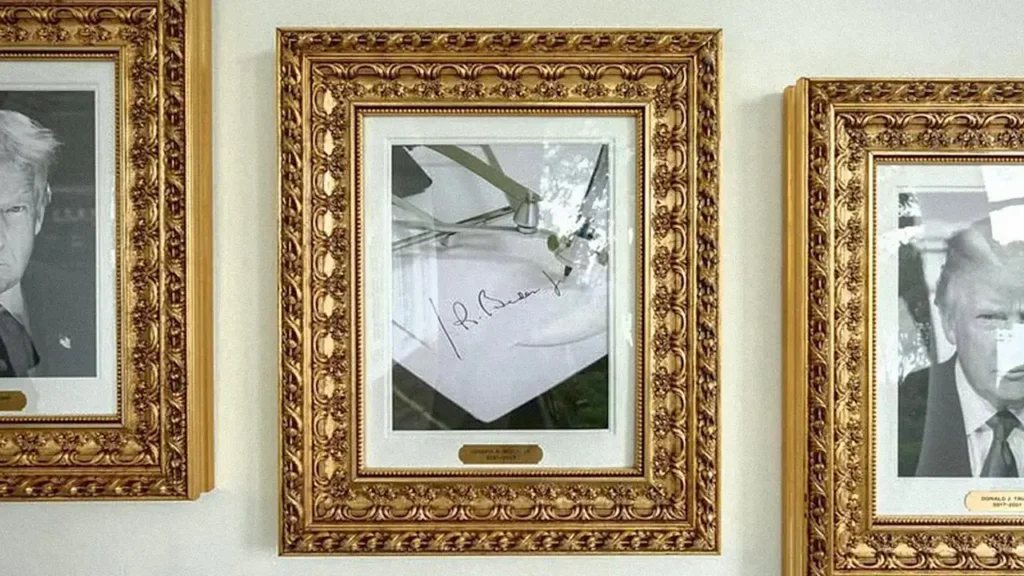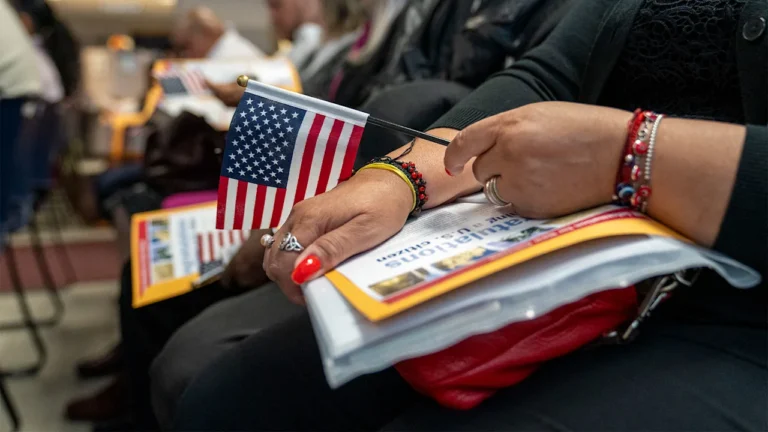
Along the White House’s West Wing Colonnade, portraits of every U.S. president since George Washington hang side-by-side in gilded frames. Every president, that is, except Joe Biden, whose visage has been swapped for an image of an autopen.
The new portrait display was unveiled on September 24, when the White House posted images of the updated West Wing to X. The post included a header image zoomed in on Biden’s spot in the lineup, which shows a black-and-white image of an autopen signing the words “Joseph R Biden Jr.” It’s in reference to a controversy, ignited earlier this year by members of the conservative think tank Heritage Foundation, who claimed that Biden’s team signed several important documents with an autopen due to the former President’s alleged “cognitive decline.”
Throughout his second term, President Trump has repeatedly used art inside the White House to meticulously edit his personal image, trading in convention to airbrush his own legacy in real time. However, this seems to be the first time that the President has moved beyond primping his own portraits to actively disparaging his political adversaries through his home decor.
Why has Biden’s portrait been replaced with an autopen?
Trump’s choice to replace Biden’s portrait with an image of an autopen is likely a move intended to insult his predecessor on an international stage.
The image refers to a controversy that cropped up back in March. At the time, Trump declared via social media that some of Biden’s presidential pardons, including members of the January 6 Committee, Dr. Anthony Fauci, and members of Biden’s family beyond his son Hunter, were void because they were signed by an autopen device.
The accusation came despite the fact that autopens, which are robotic devices used to duplicate signatures, have been used in the White House since Harry Truman. Trump himself likely used an autopen during his first term. A Republican committee, led by U.S. Representative James Comer, is currently investigating the idea that the autopen was used as a “cover-up” for Biden’s cognitive decline.
Regardless of what the committee may find, the concept of a current President using the very walls of the White House as a canvas to target a former President is essentially unheard of. For Trump, though, it’s reflective of a broader pattern.
Why this represents a concerning escalation
Immediately after taking office in January, Trump foreshadowed how he planned to rebrand his image during his second term through the reveal of his official portrait. Trump chose to scrap all previous conventions around presidential portraiture—like genial expressions and down-to-earth posing—instead choosing to model his headshot after his mugshot. Since then, the President has embarked on a months-long campaign to adopt a sterner, darker personal brand that aligns with his desired image of control.
In February, reporters spotted a framed image of a New York Post magazine spotlighting Trump’s mugshot posted just outside the Oval Office. That same month, his administration took down a minimalist portrait of former president Barack Obama in the East Room for a pop-art painting of President Trump raising his fist after the assassination attempt last year on the campaign trail. In April, a portrait of Trump’s face featuring a superimposed American flag appeared between a portrait of Hillary Clinton and Nancy Reagan. In May, a painting of Trump edited together with Abraham Lincoln and Ronald Reagan showed up in the West Wing.
And in August, deputy assistant to the President Sebastian Gorka took to X to share another new painting of Trump walking through a line of American flags with his coat billowing behind him, alongside the caption: “One of the new @WhiteHouse paintings of President @realDonaldTrump. More to come.”
Outside of art, Trump is also making several more permanent changes to the White House itself. Currently, the President is in the process of redesigning the White House’s Rose Garden in the image of his Mar-a-Lago resort and imposing his opulent, Rococo-inspired design aesthetic on a new 90,000-square-foot ballroom. In a move that almost feels closer to parody than reality, the Trump administration also recently announced plans to convert the White House’s South Lawn into a UFC arena for a 2026 match.
All of these aesthetic decisions point back to Trump’s general attitude around the White House: that it is less a historical site, and more a stage for his own personal ends—whether that means molding the building to his narrow view of “good” architecture, or using its decor to squeeze in a last jab at Biden.
